top of page
Tim Hawkinson, “Cabinet Pictures”
By DeWitt Cheng
April 6, 2024
Exhibition continuing through May 4, 2024
Hosfelt Gallery, San Francisco, California
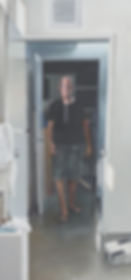
Tim Hawkinson, “Patty Reading,” 2022, oil on panel, 9 1/2 x 11 3/4”.
All images courtesy of Hosfelt Gallery
Abrupt changes in style by established artists can be surprising and even upsetting, but they can gradually be regarded as logical extensions of their oeuvre, consistent with the rest of their body of work, once we move past the initial shock and even feelings of betrayal. René Magritte’s ‘vache’ period in the late 1940s, loose, Impressionist-like brushwork treatment of earlier themes, lasted only a year or two. The artist later claimed, perhaps disingenuously, he had done them for his wife. Philip Guston and Richard Diebenkorn abandoned abstraction to return to figuration. Guston felt abstraction had become too facile, and so sought the friction of reality. Diebenkorn was responding to the tumult of the 1960s. The Great Apostate, Marcel Duchamp, abandoned making Symbolist/Futurist/Dadaist paintings in order to explore his obsessions and quirks within a broader domain of ideas — escaping the purely retinal — and blazed the trail for the conceptual art that developed fifty years later, during a period of one of painting’s imminent deaths. Duchamp later publicly renounced making art altogether — or so said the chess player component of his identity.
This brings us to Tim Hawkinson, whose absurdist humor, ingenuity, and obsessive work ethic have positioned him as a convincing heir to Duchamp, although more accessible to a general audience than the arcane, intellectual Frenchman. The artist, who grew up in the Bay Area and now lives in Los Angeles, has created some remarkable individual works over the course of his career. A large self-playing balloon-powered bagpipe from bits and pieces of hardware store bin parts and tubing titled “Überorgan” (2000) plays snatches of recognizable tunes. “Pentecost” (1999) is a huge cardboard tree of life sprouting a dozen robotic self-portraits programmed to play religious hymns. In 2005, on the occasion of Hawkinson’s retrospective at the Whitney Museum, Michael Kimmelman in The New York Times cited the “boyish charm and kooky ingenuity” required to create his “screwball contraptions”: “a busted monster truck tire out of paper, foam rubber, wire and string[,] … a clock from a tube of toothpaste[,] … a tree stump [from] cardboard and twine; and … a miniature skeleton of a bird out of fingernail clippings.”
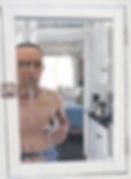
Tim Hawkinson, “Neti Self-Portrait,” 2021, oil on panel, 11 x 8 1/8”
Hawkinson’s magically transformative facility is evident in different guise in the “Cabinet Paintings” that comprise the current exhibition. The series of thirty small oil paintings on panel, exhibited unframed (so that the artifice of illusionistic art is exposed), alludes by its title to the Wunderkammer (wonder room) or Kunstkabinett (cabinet of curiosities) of Renaissance collectors of natural history specimens. Hawkinson deploys the title ironically in order to conceptually frame these paintings, most of which are vertical in format, based as they are on iPhone shots. Each is painted with a scrupulous attention to detail that borrows explicitly from Flemish depictions of Madonnas and Sacred Lambs. For instance, in “Haircut” (2023), which seemingly depicts, with casual abandon, a moment at the stylist’s, two details catch the eye: a small gold-colored depiction of Leonardo’s “Last Supper” atop the mirror; and on a shelf to the right a small postcard of Zurbarán’s 1635 “Agnus Dei” (Lamb of God), the creature’s legs bound, innocently awaiting its fate, being shorn or butchered.
The paintings, made during the recent two years when the Covid-19 pandemic redirected our energies inward, focus on family life, predominantly moments of humble, routine ordinariness that caught the artist’s eye. But they are also about what we might call metaphysical or spiritual import, akin to the expressionist paintings of Edvard Munch, though calmly and lovingly depicted. The ordinary and the transcendental are not distinct realms, but shade into each other.
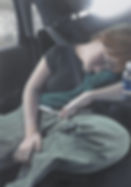
Tim Hawkinson, “College Tour," 2022, oil on panel, 10 3/8 x 7 3/8"
In “Hand and Feet” (2021) the artist’s huge left hand and, far below, his bare feet, are foreshortened into a cascade of fingers and toes. “Dad Cutting His Toenails” (2021) shows the old man intently focused on his grooming, seated near a door and bathed by illumination from a skylight. The accidental spotlight as a possible symbol for knowledge or grace also appears in “Patty in a Ray of Light” (2021) and “Me in a Ray of Light” (2023), in which the artist and his wife, painter Patty Wickman, are caught going about the business of daily life illumined by this brief blink of sunlight.
Two self-portraits in a mirror expose a bare-chested, vulnerable man, less the posturing or posing associated with the genre. “Neti Self-Portrait” (2021) shows the artist reflected in the bathroom medicine cabinet mirror, having just taken a nasal irrigation treatment. “Turlock Hotel, Self-Portrait” (2022) shows the naked artist, eyes closed, holding an ironing board, while a coffee maker and his keys await, and coat hangers invade the space from the right. The bare chest and bluish palettes of these paintings relate them to “Pacemaker” (2021), which depicts the artist’s father outfitted with a heart monitor and a blue covid mask.

Tim Hawkinson, "Patty Reading,” 2022, oil on panel, 9 1/2 x 11 3/4"
Domestic scenes extend to the whole family and are equally candid no matter who is the subject. Hawkinson’s wife and daughter appear in “Patty Checking on Clare” (2005, 2021), a view past a door into a shadowy hallway in which the mother listens at a bedroom door. “Reading to Clare” (2023) depicts Hawkinson looking up from a book to check on his young daughter, who wears a jaw restraint to bed. In “Clare/Plane” (2021) the teenage daughter naps in her airplane seat, wearing a frilly sleep mask and a black N5 covid mask. “College Tour” (2022) has the exhausted girl sleeping on the car’s back seat.
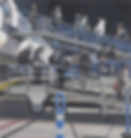
Tim Hawkinson, “Burbank,” 2022, oil on panel, 9 1/8 x 8 3/4”
Three of the paintings look back to Hawkinson’s mordantly funny sculptural work. “1993” (2021) depicts the artist having a latex mold of his body made for “Balloon Self-Portrait” (1993). “Headweight” (2022) shows the artist, unshaven and blotchy, lying with his twelve-pound head on a bathroom scale — a strange halo — in a wordplay on ‘dead weight.’
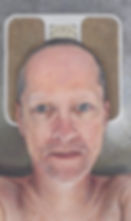
Tim Hawkinson, “Headweight,” 2022, oil on panel, 11 1/4 x 7”
One of the paintings that departs from the iPhone’s vertical format is “Burbank” (2022), a squarish-format depiction of the rollaway ramps used in regional airports. Hawkinson calls attention to how they zigzag up towards the airplane door, bearing a procession of masked passengers. The exquisite paint handling elevates this and other un-momentous moments into diminutive icons of our unsettled and unsettling times.
DeWitt Cheng is an art writer/critic based in the San Francisco Bay Area. He has written for more than twenty years for regional and national publications, in print and online, He has written dozens of catalogue essays for artists, galleries and museums, and is the author of “Inside Out: The Paintings of William Harsh.” In addition, he served as the curator at Stanford Art Spaces from 2013 to 2016, and later Peninsula Museum of Art, from 2017 to 2020.
bottom of page

